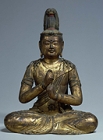Japanese Gallery (Honkan) Room 12
July 22, 2009 (Wed) - October 12, 2009 (Mon)
Unkei, active from the late Heian (794-1192) to the early Kamakura (1192-1333) periods, is one of the most important Buddhist sculptors in the history of Japanese sculpture. He belonged to the group of Buddhist sculptors now known as the Kei school, which was active in Nara. Being the earlier capital, many Tenpyo style sculptures of the Nara period (710-794) were preserved there. Unkei studied these classical works and created a new style which was realistic and dynamic.
Unkei worked not only for the old customers in Nara and Kyoto; he also met the demands of the new power in Japan, the Kamakura military government. Works for the new patrons included the statues preserved at Ganjojuin in Shizuoka commissioned by Hojo Yorimasa, the father-in-law of the first shogun Minamoto no Yoritomo. The two statues of Dainichi Nyorai (Mahavairocana), owned by Kotokuji temple and Shinnyoen respectively, are thought to have been produced by Unkei and possibly commissioned by Ashikaga Yoshikane, a vassal of the shogun. Through these works Unkei's style spread among the Kanto region sculptors.
This thematic display features: the two statues of Dainichi Nyorai, which are most probably by Unkei himself; the Twelve Heavenly Generals, which some scholars think were produced at Unkei's studio; some Unkei style statues from the Kanto region; as well as works by Koen, Unkei's grandson.

